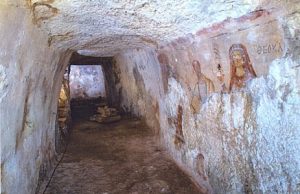Grotto of St. Paul in Ephesus

Apostle Paul arrives to Ephesus in the autumn of 54 A.D, during his third missionary journey, and he lives in the city for more than three years. For three months, Paul spoke boldly in the Synagogue (Acts 19:8). Then he continued spreading the gospel in the school of Tyrannus for two years (Acts 19:9).
During the excavations, a cave that contains important Early Christian frescoes and inscriptions was discovered in the the southern side of ancient Ephesus on the slope of Bülbüldağ hill (Nightingale Mountain). ln 1995 Dr. Renate Pillinger from the University of Vienna discovered an early fresco on the western wall of the grotto’s passageway that includes a clear Picture of the Apostle Paul.
 The cave has been a Christian sacred site since the 1st or the 2nd century, and it may have been associated with the St Paul’s ministry in Ephesus. According to Cengiz Içten, archaeologist who has been working for years in Ephesus, before it was discovered, the cave had probably been used by local shephards who limewashed the plasters. Over the course of centuries the grotto was decorated with frescoes and inscriptions. After the the Greek -Turkish Population Exchange 1923-1924, local Christians in the area had to leave their homes and move to Greece, so the cave was abandoned.
The cave has been a Christian sacred site since the 1st or the 2nd century, and it may have been associated with the St Paul’s ministry in Ephesus. According to Cengiz Içten, archaeologist who has been working for years in Ephesus, before it was discovered, the cave had probably been used by local shephards who limewashed the plasters. Over the course of centuries the grotto was decorated with frescoes and inscriptions. After the the Greek -Turkish Population Exchange 1923-1924, local Christians in the area had to leave their homes and move to Greece, so the cave was abandoned.
Inside of the cave, there is a portrait of Paul from the 5th century with the early twentieth-century grafittis written in charcoal and chalk that read "the hidden of Mother of God" and "Paul help your servant."
The other fresco from the Old Testament is the scene of The Prophet Abraham sacrificing his own son Isaac was painted in the left part of the entrance on the eastern wall.
There is also a representation of Saint George painted in 12th-13th century. Only yellow Nimbus, armored shoulder, spear and shield are seen.
On biggest fresco the Theophanie (a god welcoming scene) is represented. In the middle golden cross shaped Nimbus and Jesus are sitting on the rainbow. On his both sides two apostles represented from front are commented as prophet or saint.
Three persons represented, coming turned to Jesus might be the family who has dedicated frescos. The family comes in front of Jesus for wish.
On side walls on the same layer, Nimbus with a woman and a man are seen. These are native saints and bishops.
 One of the interesting scenes is the one of Saint Thecla, peering out a window who and listening Saint Paul who is outside. Paul is shown seated with a book on his lap, while his right hand is up with two extended fingers as a preaching gesture. Behind Paul on the right, there is Thecla’s mother standing with her right hand up for warning.
One of the interesting scenes is the one of Saint Thecla, peering out a window who and listening Saint Paul who is outside. Paul is shown seated with a book on his lap, while his right hand is up with two extended fingers as a preaching gesture. Behind Paul on the right, there is Thecla’s mother standing with her right hand up for warning.
Who is Thecla?
There is an episode in the apocryphal book, Acts of Paul and Thecla from the 2nd century, about Paul preaching in Iconium about living with virginity and prayer. Engaged Thecla is banned from going out, so she listens excitedly from her window. After the preach Thecla breaks engagement without listening warnings of her mother Theocleia. Opposed by her surrounding, while even her mother shouts “Burn the wicked wretch, she endures hositility and torture, but miraculosly survives it all and starts to teach the word of God.
Grotto of St. Paul is not open to the public. It is possible to visit the Grotto with after taking permission from the Ephesus Museum management.
You can watch our video about Ephesus
